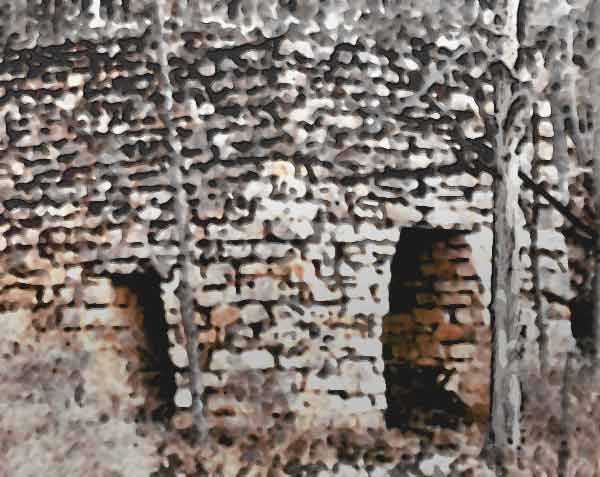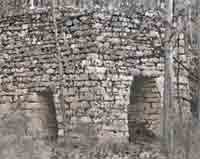Shenandoah County's Iron Industry
In the early 1700s settling of Shenandoah, iron was produced with raw materials found along the mountains on either side of the Valley. The antebellum furnace industry was Shenandoah County's primary manufacturing.
In theory all that was needed was fuel, flux, ore, and water. The fuel was charcoal made from the abundant forests, and charcoal making was an industry in it's own right. The iron-ore was found as thin layers in yellow shale, often called 'soft-shale'; and occasionally found as purpley-red hematite. Limestone found throughout the Valley served as flux, the material that floated on the molten iron and kept it from burning -iron will burn if it's hot enough.

In practice the furnace had to be near the base of a steep slope or cliff so the top-loaded furnace could be filled. The creek or stream had have enough fall to power a mill-wheel, and --at some point-- to run close to the furnace base. A source of granite or silica rock was needed to make the furnace structure itself, but wasn't needed very often. One more practical consideration was the furnace needed to be downhill from the ore and flux deposits!
Requiem
William Didawick was bitten by the 'furnace bug' early in life. Unlike many of us who are fascinated by these silent giants of the distant past, Bill wasn't content to just take a few photos; he immersed himself in the subject. From how iron-ore was located, to what final products were made and where they were shipped; if it was about 18th or 19th century iron, Bill knew it.
In my last conversation with Bill, he described his interest shifting from the physical toward the social: To the people who worked the iron industry, workers who shoveled tons of ore each day, the booming towns that are now trackless forest, and the surprising effect on slavery.
Bill Didawick significantly advanced our understanding of Shenandoah history during the colonial, Federal and westward expansion periods. He was just a great guy too, and is very missed.
Other sites describe the early iron furnaces and industry better than I can, so please use the links on the right. There are a few subjects the other sites don't cover though
Respect the past, and respect the present too. Please don't trespass on private property -especially posted land- like these people did just to get some photos. There are furnaces on National Forest property if you need closeup photos or feel the need to touch.
The huge amount of stone in each furnaces makes them obvious, but the furnace itself was a small part of what it represents. The remains of the pit or shaft mines are in the forests, and the drag-roads to bring the ore down are easy to spot once you learn how. If you're exploring in the woods, you're probably walking on the remains of a drag-road!
Liberty and Columbia furnaces shipped cast iron out on a narrow-gauge railroad called The Dinky to Edinburg where it was transfered to a Shenandoah River barge or (later) to rail cars. Dirt roads that paralleled the rail are now paved while the rail is gone; but the rail-bed is still there if you look.
Most of the iron itself is long shipped away, though Catherine Furnace boasts one enormous ingot on site. But the colored glass -in every shade of blue, green, red- from the flux is still found. The publically accessible parts of Stoney Creek downstream or even along the road are places to look.
Some information on iron furnaces is good, but should be taken with a grain of salt. They are written with good intentions, but.... The name "pig iron" came from the poured shape of the ingots, not the sucking sound the metal (didn't) make!
In many ways the charcoal-fueled iron made in the old furnaces is far better than iron available today. It's more rust resistant, less brittle, has a wider working range, welds more completely, and takes a finer finish. It was a superb product, and our forefathers should be proud of it.
But these magnificent furnaces required enormous amounts of trees as fuel Fuel –as much as five acres of woods per day— filling the air with their smoke and stripping the forests. It's also true they worked many of our forefathers to death, crippling or burning many others. It's good they no longer operate, but it's good these monuments still stand.
 Henrietta Furnace at Shenandoah Alum Springs
Henrietta Furnace at Shenandoah Alum SpringsA defective flue kept it from being used much during it's brief lifetime. It was run so little almost all its damage is from age, weather, and vandalism; not from heat-corrosion.
Early Iron
One of the finest Valley iron sites is from VMI's cadets
LSU's Civil War Iron Production
Shenandoah Gen Web Furnace Information
Appalachian Blacksmiths Association
Related Links:
Slavery in the Mining and Smelting Industries

